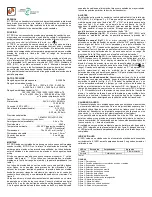
4200 Series Transmitters
Instruction Manual
Form 5596
July 2005
16
Arrange wires on the terminal block (TB1) for either
direct or reverse action to match the application
requirements; then repeat the potentiometer
alignment procedures.
Refer to the Calibration section to adjust the zero
and span of the transmitter and/or position switch
circuits.
Operating Information
Initial Considerations
If the transmitter is ordered with an actuator, the
transmitter is factory calibrated to the length of travel
specified on the order. If the transmitter is ordered
separately, adjust the zero and span as described in
the Calibration section so that the transmitter
operates properly in your specific application.
If the transmitter is calibrated for a specific control
valve actuator travel, perform the procedures in the
Calibration section to fine tune the zero and span
adjustments to the specific application.
Transmitter and Position Switch
Conditions
D
A Type 4210 or 4220 transmitter (with position
switches) obtains stem position from the input
potentiometer and circuit electronics to provide a 4
to 20 milliampere output. The transmitter output
connects to a terminal block mounted in the field
wiring compartment. The high position switch circuit
output controls relay K1 mounted on the field circuit
printed wiring board, and the relay contacts connect
to TB1. The low position switch circuit output
controls relay K2, and the relay contacts connect to
TB2. The relationship between the transmitter
output, relay position switch outputs, and deadband
is shown in figure 7. Deadband is the difference
between trip and reset points of a relay.
D
A Type 4211 or 4221 transmitter (without
position switches) obtains input information from the
potentiometer and provides a 4 to 20 milliampere
output. The transmitter output connects to the barrier
strip (key 11, figure 4) mounted in the field wiring
compartment.
D
A Type 4212 or 4222 position switch (without
the transmitter) obtains stem position from the input
potentiometer and provides position switch outputs
from relays K1 and K2 (figures 4 and 9). The high
position switch circuit output controls relay K1
mounted on the field circuit printed wiring board and,
the relay contacts connect to TB1. The low position
switch circuit output controls relay K2 and, the relay
contacts connect to TB2. Deadband is the difference
between trip and reset points of a relay.
D
A Type 4215 transmitter obtains position
information from a dual potentiometer on the same
shaft, which allows for individual potentiometers for
the transmitter circuit and the position switch circuits.
The transmitter input is from one of the
potentiometers and its output connects to TB3
(figure 6) mounted on the field circuit printed wiring
board. The position switch input is obtained from the
other potentiometer.
The high position switch circuit output controls relay
K1 mounted on the field circuit printed wiring board
and the relay contacts connect to TB1. The low
position switch circuit output controls relay K2 and
the relay contacts connect to TB2. The relationship
between the transmitter output, relay position switch
outputs, and deadband is shown in figure 7.
Deadband is the difference between the trip and
reset points of a relay.
Normal Operation
WARNING
On an explosion-proof instrument,
remove electrical power before
removing the instrument covers in a
hazardous area. Personal injury or
property damage may result from fire
or explosion if power is applied to the
instrument with the covers removed, in
a hazardous area.
Once the instrument has been calibrated and placed
in operation, further adjustments should not be
necessary. The 4 to 20 milliampere output can be
monitored during operation (in a non-hazardous
environment) by removing the cover and connecting
a milliammeter between TP1 (+) and TP2 (−) on the
printed wiring board (figure 5) on Type 4210, 4211,
4215, 4220, or 4221 transmitter. On Type 4212 or
4222 connect a voltmeter between TP5 (+) and TP6
(−) to measure potentiometer position.
For position switch circuits, the switching condition
can be monitored by observing the indicating device
or using an ohmmeter connected to the terminal
















































